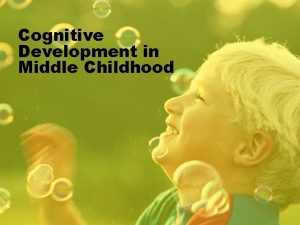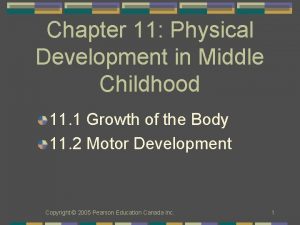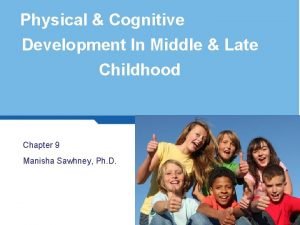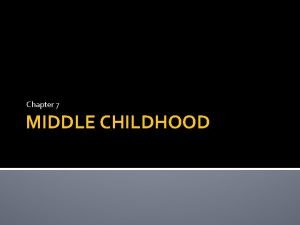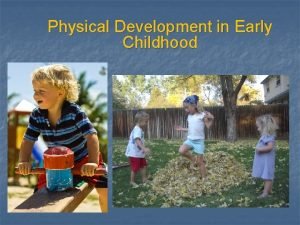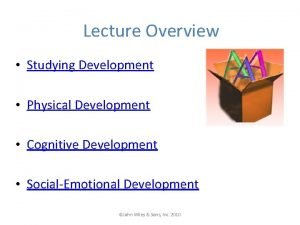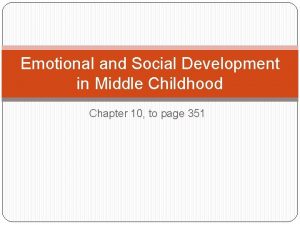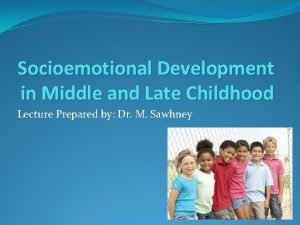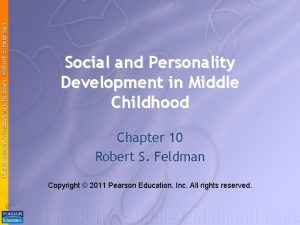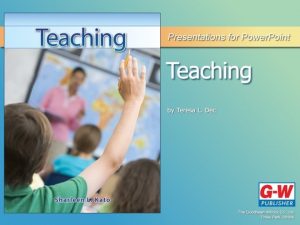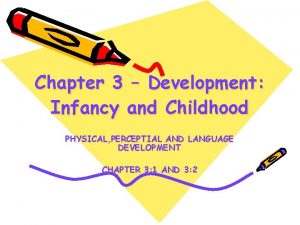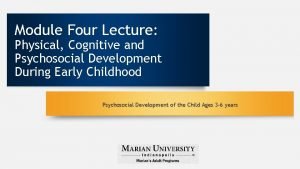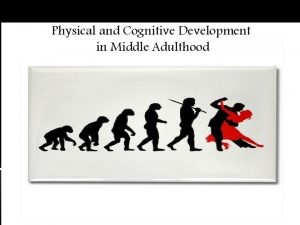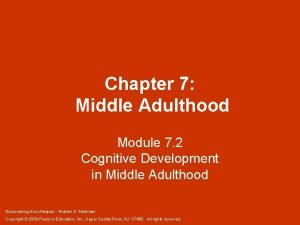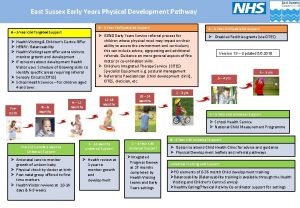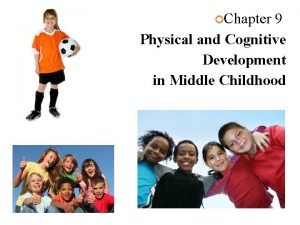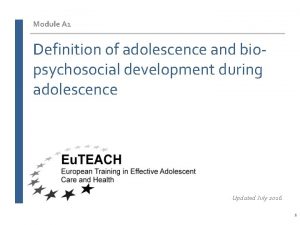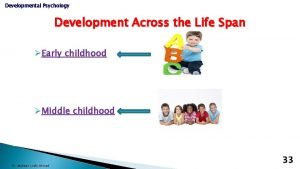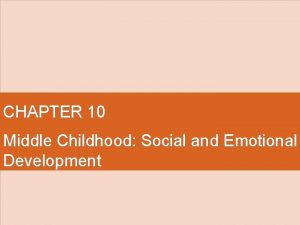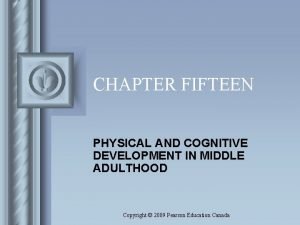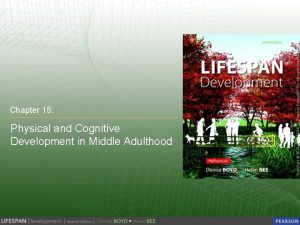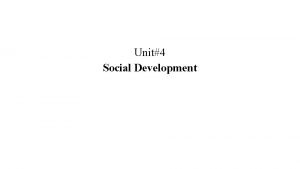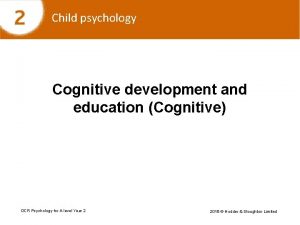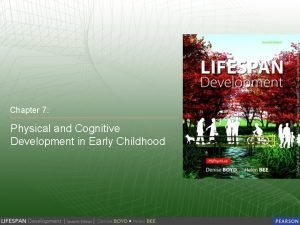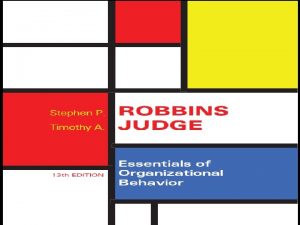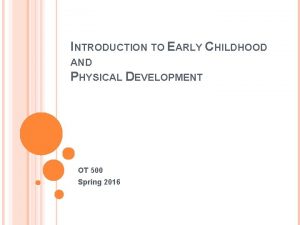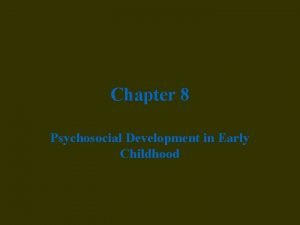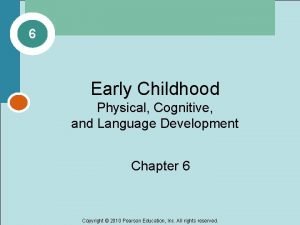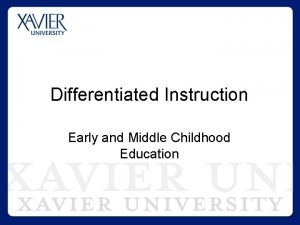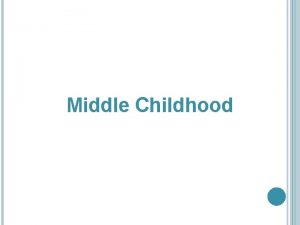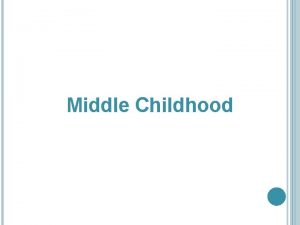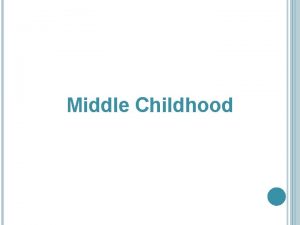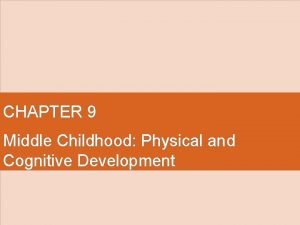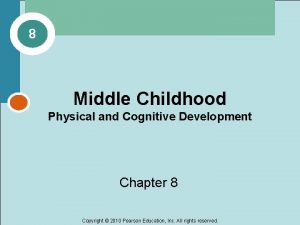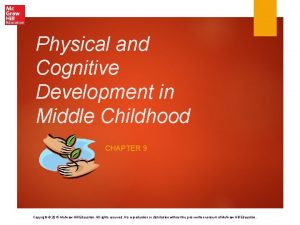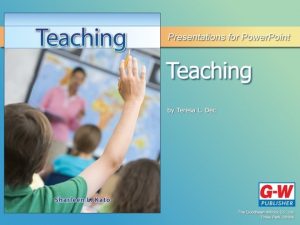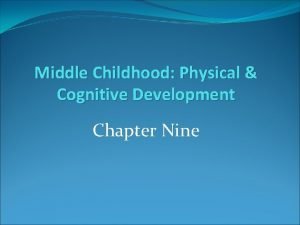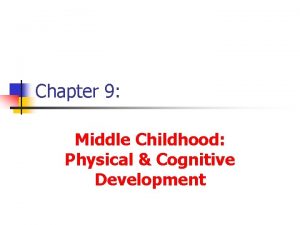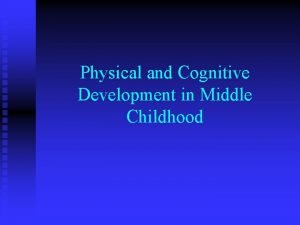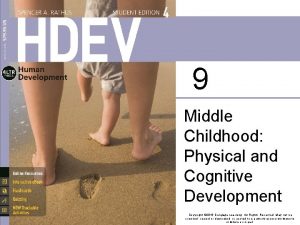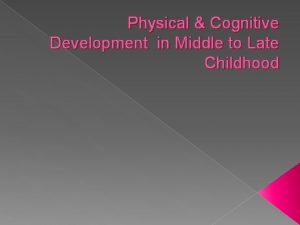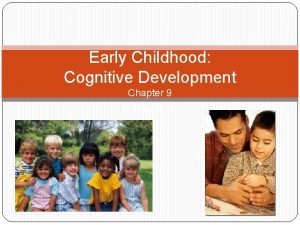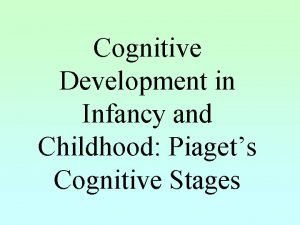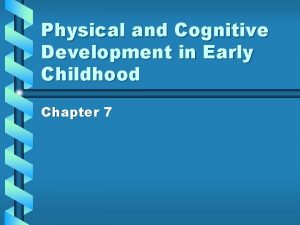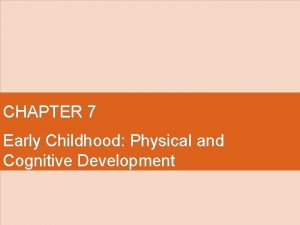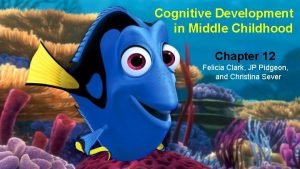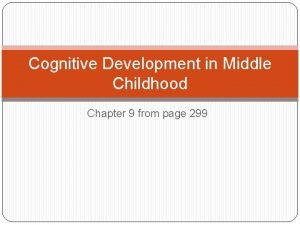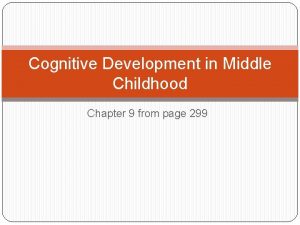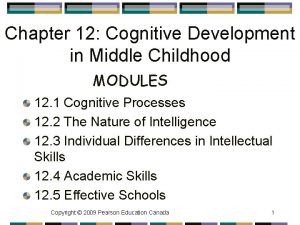Physical and Cognitive Development in Middle Childhood Chapter













































- Slides: 45

Physical and Cognitive Development in Middle Childhood Chapter 9

Physical Development-Body Growth § Physical growth during the school years continues at a slow pace § At age 6 the average American child weighs about 45 pounds and is 3 and a half feet tall § Between ages 6 and 8, girls are slightly shorter and lighter than boys • During middle childhood, children experience a greater desire for physical exercise • Beginning ages 6 and 12, all 20 primary teeth are lost and replaced by permanent ones

Health Issues § Poverty is a powerful predictor of ill health during the school years § Economically disadvantaged U. S families often lack health insurance, many children do not have access to a doctor § Some children also lack regular meals

Nutrition § School aged children need a well balanced diet to provide energy for learning and physical activity § Many children spend little time dining with their families § The percentage of those who eat dinner with their families drops between the ages of 9 and 14 § Those who eat dinner with their families tend to eat fruits , vegetables, grains and milk products and do not drink soft drinks and eat fast foods § Poverty stricken children in developing countries and U. S. suffer from malnutrition

Overweight and Obesity § There is a rise in overweight and obesity § 32% of U. S. children and adolescents are overweight § 17% are obese § Boys are more affected than girls § In some cultures like China, excess body fat signifies prosperity and health § In the Chinese culture, it was believed that famine caused millions of deaths some time ago

Overweight and Obesity § So parents offer their sons energy dense foods § Overweight increases with age § About 70% of affected teenagers become overweight adults § Obesity has caused a dramatic rise in cases of diabetes in children which sometimes leads to stroke, kidney failure, circulatory problems that heightens the risk of blindness and leg amputation.

Causes of Obesity § Overweight children tend to have overweight parents § Heredity accounts might be a cause for gaining weight § Factors include lack of knowledge about healthy diet, a tendency to buy high fat low cost foods and family stress which can prompt overeating § Children who were undernourished in their early years are at risk for later excessive weight gain § Some parents overfeed their children § Other parents pressure their children to eat § Some parents are controlling

Causes of Obesity § Parents of overweight children often use high fat, sugary foods to reinforce other behaviors leading children to attach great value to treats. § Another factor associated with weight gain is insufficient sleep § Reduced sleep may increase time available for eating. This leaves children too tired for physical activity. § Overweight children are less physically active than their normal weigh peers § Research reveals that the rise in childhood obesity is due in part to many hours U. S. children spend watching television § The more TV children watched the more body fat they added § Watching TV reduces time spent in physical activity

Causes of Obesity § TV advertisements encourage children to eat fattening unhealthy snack § Children who are permitted to have a TV in their bedroom are at even further risk for overweight § The number of families who frequently eat meals outside the home risen dramatically § Eating in restaurants as opposed to at home increases children overall food consumption

Psychological and Social Consequences of Obesity §Stereotyping/teasing §Social isolation §Depression §Emotional, academic, and behavior problems §Reduced life chances

Treating Obesity § Family-based interventions: • diet change • exercise program • positive reinforcement § School environment: • screenings • improved nutrition standards • additional recess/physical education time • obesity awareness programs

Illness in Middle Childhood § High rates in first two years of school § 15 percent have chronic conditions: • asthma • severe illnesses, such as sickle cell anemia, cancer, and diabetes

Asthma • Bronchial tubes highly sensitive to stimuli: • cold, infection, allergies, stress • wheezing, coughing, breathing problems • Risk factors: • • • heredity pollution stressful home life poor health care obesity

Gross Motor Development § Gross motor (physical) skills are those which require whole body movement and which involve the large muscles of the body to perform everyday functions, such as standing, walking, running, and sitting upright. It also includes eye-hand coordination skills such as ball skills (throwing, catching, kicking).

Fine motor Development §Fine motor skills are finger and hand skills such as writing, cutting, opening lunch boxes, and tying shoelaces

Motor Development in Middle Childhood § Gross-motor skill gains: • flexibility • balance • agility • force § Fine-motor skill gains: • writing • drawing

Sex Differences in Motor Development Boys better Girls better at grossat finemotor skills, motor skills sports

Games with Rules §Games with rules: • sports • Invented games • Adult-organized sports • Rough-and-tumble play: establishes dominance hierarchy § Physical education

Conservation Reversibility Decentration Thinking through a Focusing on series of steps several aspects and then mentally of a problem and reversing direction relating them

Classification § Children pass the class inclusion problem between ages 7 and 10 § This indicates that they are more aware of classification hierarchies and can focus on relations between a general category and two specific categories at the same time § Collecting and classifying items become common

Seriation • Ability to order items along a quantitative dimension—becomes efficient around 6– 7 years • Transitive inference: ability to seriate mentally— appears around 7 years

Spatial Reasoning § Preschoolers and young school-age children include landmarks on the maps they draw, but their arrangement is not always accurate § Around age 8 and 10, children maps become better organized showing landmarks along an organized route of travel § By the end of middle childhood, children combine landmarks and routes into an overall view of a large scale space

Limitations of Concrete Operational Thought • Operations are concrete: • applied to information children can perceive directly • work poorly with abstract ideas • Continuum of acquisition: children master concrete operational tasks gradually, step by step

Follow-up Research on Concrete Operational Thought • Culture and schooling affect task performance: • Going to school provides experiences relevant to Piagetian tasks. • Certain non-school, informal experiences in some cultures foster concrete operations.

Information Processing §The information-processing perspective examines separate aspects of thinking

Attention in Middle Childhood Attention becomes more • selective • adaptable • planful

Memory Strategies Rehearsal (early grade school) § repeating information to oneself Organization (early grade school) § grouping related items together Elaboration (end of middle childhood) § creating a relationship between pieces of information not in the same category

Attention-Deficit Hyperactivity Disorder • Inattention • Impulsivity • Excessive motor activity • Results in • academic problems • social problems

Treatment of ADHD § Stimulant medication: § improves attention, academic performance, and peer relations for 70% § insufficient by itself § Family intervention § Adults with ADHD need ongoing assistance

Knowledge Base and Memory • Becomes increasingly elaborate and better organized • Motivated learners actively use what they know to expand their knowledge. • leads to greater academic success

Culture, Schooling, and Memory Strategies Memory strategies are mostly useful for recalling isolated bits of information.

Promoting Cognitive Self-Regulation § Point out important features of tasks. § Suggest effective learning strategies. § Emphasize monitoring of progress.

Information Processing and Academic Learning • Reading: • phonological awareness, information-processing speed, and visual discrimination contribute to reading skills • blend whole-language and phonics approaches • Mathematics: • learn facts and procedures through practice, reasoning, experimenting with strategies • blend drill and “number sense” approaches

Intelligence Tests Group Tests Individual Tests • Allow testing of large groups • Require little training to administer • Useful for instructional planning • Identify students who need individual testing • Require training and experience to administer • Provide insights about accuracy of score • Identify highly intelligent children and children with learning problems

Sternberg’s Triarchic Theory of Successful Intelligence

Gardner’s Multiple Intelligences • • Linguistic Logico-mathematical Musical Spatial Bodily-kinesthetic Naturalist Interpersonal Intrapersonal

Nature, Nurture, and IQ § The IQ scores of identical twins are more similar than those of fraternal twins § Researchers suggest that about half the differences in IQ among children can be traced to their genetic makeup § When young children are adopted into caring stimulating homes, their IQs rise compared with the IQs of non-adopted children who remain in economically deprived families

Cultural Bias in Testing • Cultural influences affect test performance: • communication styles • test content • Stereotypes Refer to page 246 (What does your textbook say? )

Reducing Cultural Bias in Testing § Combine test scores with assessment of adaptive behavior § Culturally relevant testing procedures: dynamic assessment

Language Development § During the elementary school • When children read, it years, vocabulary increases contributes to vocabulary growth § School aged children add to their vocabularies by analyzing the • Children gain mastery of structure of complex words complex grammatical constructions § Children at a younger age benefit from having • There is also an improvement in conversations with more expert pragmatics which is the speakers communicative side of language

Learning Two Languages § Bilingual development: § learn both languages at the same time or learn first language, then second § sensitive period during childhood § Bilingual education: § language immersion § English-only programs: risk of inadequate proficiency in both languages

Educational Philosophies • Traditional vs. constructivist • New philosophical directions: social-constructivist • teachers and children as partners • many types of symbolic communication • teaching adapted to zone of proximal development • cooperative learning

Teacher–Student Interaction • Teachers: • Self-fulfilling prophecies: have greater impact on low • caring, helpful, stimulating, emphasizing high-level thinking achieving students —fosters achievement • use of repetitive drill, bias in favor of well-behaved students— impedes achievement • homogenous ability groups—a potent source

Teaching Children with Learning Difficulties • Children often placed in regular classrooms: • mild mental retardation • learning disabilities: 5– 10% of school-age children • Law requires “least restrictive” environment: inclusive classrooms • full inclusion • resource rooms

Educating Gifted and Talented Children § Gifted: exceptional intellectual strengths § Talented: outstanding in a specific field § Educational approaches: § § enrichment in regular classroom pull out for special instruction move to higher grade multiple intelligences models
 Late childhood cognitive development
Late childhood cognitive development Language development in middle childhood
Language development in middle childhood Physical development in middle childhood chapter 11
Physical development in middle childhood chapter 11 Middle and late childhood physical development
Middle and late childhood physical development Middle childhood is from
Middle childhood is from Physical development in middle childhood
Physical development in middle childhood Kellogg drawing stages
Kellogg drawing stages Chapter 9 early childhood cognitive development
Chapter 9 early childhood cognitive development Module 47 infancy and childhood cognitive development
Module 47 infancy and childhood cognitive development Module 47 infancy and childhood cognitive development
Module 47 infancy and childhood cognitive development Three prenatal stages
Three prenatal stages Social development in middle childhood
Social development in middle childhood Socioemotional development in middle and late childhood
Socioemotional development in middle and late childhood Personality development in middle childhood
Personality development in middle childhood Middle childhood growth and development
Middle childhood growth and development Internally programmed growth of a child
Internally programmed growth of a child Rovee-collier
Rovee-collier Cognitive development early adulthood
Cognitive development early adulthood Physical development during early adulthood
Physical development during early adulthood Define physical cognitive and psychosocial development
Define physical cognitive and psychosocial development Cognitive development for middle adulthood
Cognitive development for middle adulthood Middle adulthood cognitive development
Middle adulthood cognitive development Physical development in early childhood
Physical development in early childhood Cognitive and non cognitive religious language
Cognitive and non cognitive religious language Chapter 5 cognitive development in infancy and toddlerhood
Chapter 5 cognitive development in infancy and toddlerhood Middle and late childhood
Middle and late childhood Middle adolescence physical development
Middle adolescence physical development Middle adulthood physical changes
Middle adulthood physical changes Early adulthood stage
Early adulthood stage Developmental psychology
Developmental psychology Middle childhood definition
Middle childhood definition Denny's model of physical and cognitive ageing
Denny's model of physical and cognitive ageing Denny's model of physical and cognitive ageing
Denny's model of physical and cognitive ageing Social development in infancy and childhood
Social development in infancy and childhood Education cognitive development
Education cognitive development Physical changes during childhood
Physical changes during childhood Self-determination theory
Self-determination theory Fine motor skills development in early childhood
Fine motor skills development in early childhood Adulthood social development
Adulthood social development Psychosocial development in early childhood
Psychosocial development in early childhood Language development in early childhood
Language development in early childhood Late childhood
Late childhood What is biosocial development in early childhood
What is biosocial development in early childhood Ldoe delivery recipes
Ldoe delivery recipes Intellectual development in later adulthood
Intellectual development in later adulthood Gerome bruner
Gerome bruner

